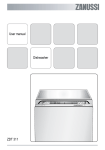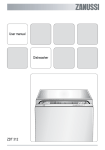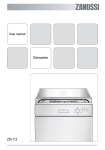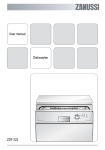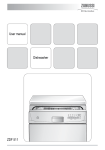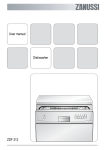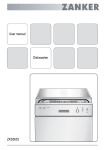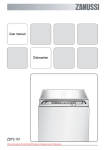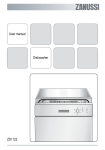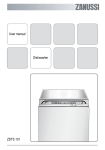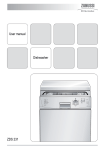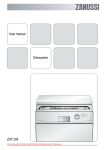Download Zanussi ZDT311 User manual
Transcript
User manual
Dishwasher
ZDT 311
Downloaded from DishWasher-Manual.com Manuals
Thank you for selecting our
appliance
We wish you lots of enjoyment with your new
appliance and we hope that you will consider
our brand again when purchasing household
appliances.
Please read this user manual carefully and
keep it throughout the product life cycle as a
reference document. The user manual should
be passed on to any future owner of the
appliance.
Contents
Safety information _ _ _ _ _ _ _ _ _ _ _ _ _ 3
Use of detergent _ _ _ _ _ _ _ _ _ _ _ _ _ 16
Control panel _ _ _ _ _ _ _ _ _ _ _ _ _ _ _ 4
"Multi-Tab function" _ _ _ _ _ _ _ _ _ _ _ 17
Audible signals _ _ _ _ _ _ _ _ _ _ _ _ _ _ 5
Unloading the dishwasher _ _ _ _ _ _ _ _ 19
Select and start a washing
programme _ _ _ _ _ _ _ _ _ _ _ _ _ _ _ _ 6
Care and cleaning _ _ _ _ _ _ _ _ _ _ _ _ 19
Washing programmes _ _ _ _ _ _ _ _ _ _ _ 8
First use _ _ _ _ _ _ _ _ _ _ _ _ _ _ _ _ _ _ 9
Environmental concerns _ _ _ _ _ _ _ _ _ 21
Something not working _ _ _ _ _ _ _ _ _ 21
Consumption values _ _ _ _ _ _ _ _ _ _ _ 23
Set the water softener _ _ _ _ _ _ _ _ _ _ _ 9
Technical data _ _ _ _ _ _ _ _ _ _ _ _ _ _ 24
Filling with dishwasher salt _ _ _ _ _ _ _ 11
Hints for test institutes _ _ _ _ _ _ _ _ _ _ 24
Filling with rinse aid _ _ _ _ _ _ _ _ _ _ _ 12
Installation _ _ _ _ _ _ _ _ _ _ _ _ _ _ _ _ 25
Adjusting the dosage of rinse aid _ _ _ _ 13
Loading cutlery and dishes _ _ _ _ _ _ _ 13
2Downloaded from DishWasher-Manual.com Manuals
Safety information
In the interest of your safety and to ensure the
correct use, before installing and first using the
appliance, read this user manual carefully, including its hints and warnings. To avoid
unnecessary mistakes and accidents, it is important to ensure that all people using the
appliance are thoroughly familiar with its operation and safety features. Save these instructions and make sure that they remain with the
appliance if it is moved or sold, so that everyone
using it through its life will be properly informed
on appliance use and safety.
Correct use
• This dishwasher is only intended for washing
household utensils suitable for machine
washing.
• Do not put any solvents in the dishwasher.
This could cause an explosion.
• Knives and other items with sharp points
must be loaded in the cutlery basket with
their points down or placed in a horizontal
position in the upper basket.
• Only use products (detergent, salt and rinse
aid) suitable for dishwashers.
• Avoid opening the door whilst the appliance
is in operation, hot steam may escape.
• Do not take any dishes out of the dishwasher
before the end of the dishwashing cycle.
• After use, isolate the appliance from the
power supply and turn off the water supply.
• This product should be serviced only by an
authorised service engineer, and only genuine spare parts should be used.
• Under no circumstances should you attempt
to repair the machine yourself. Repairs car-
ried out by inexperienced persons will cause
injury or serious malfunctioning. Contact
your local Service Force Centre. Always insist on genuine spare parts.
General safety
• Dishwasher detergents can cause chemical
burns to eyes, mouth and throat. Could endanger life! Comply with the safety instructions of the dishwasher detergent
manufacturer.
• The water in your dishwasher is not for drinking. Detergent residues may still be present
in your machine.
• Ensure that the door of the dishwasher is
always closed when it is not being loaded or
unloaded. In this way you will avoid anybody
tripping over the open door and hurting
themselves.
• Do not sit or stand on the open door.
Child safety
• This appliance is designed to be operated
by adults. Don’t allow children to use the
dishwasher unsupervised.
• Keep all packaging well away from children.
There is risk of suffocation.
• Keep all detergents in a safe place out of
children’s reach.
• Keep children well away from the
dishwasher when the door is open.
Downloaded from DishWasher-Manual.com Manuals
3
Installation
• Check your dishwasher for any transport
damage. Never connect a damaged machine. If your dishwasher is damaged contact your supplier.
• All packaging must be removed before use.
• Any electrical and plumbing work required to
install this appliance must be carried out by
a qualified and competent person.
• For safety reasons it is dangerous to alter
the specifications or attempt to modify this
product in any way.
• Never use the dishwasher if the electrical
supply cable and water hoses are damaged;
or if the control panel, work top or plinth area
are damaged such that the inside of the appliance is freely accessible. Contact your
local Service Force centre, in order to avoid
hazard.
• All sides of the dishwasher must never be
drilled to prevent damage to hydraulic and
electric components.
WARNING!
For electrical and water connection carefully
follow the instructions given in specific paragraphs.
Control panel
1
A
2
B
C
5
1
2
3
4
5
On/Off button
Programme selection buttons
Delay start button
Indicator lights
Function buttons
Functions buttons
4Downloaded from DishWasher-Manual.com Manuals
3
4
In addition to the dishwashing programme selection, the following functions can also be set
with the help of these buttons:
• the setting of the water softener,
• deactivation/activation of the audible signals.
• cancel a washing programme or a delay start
in progress
• activation/deactivation of the rinse aid
dispenser when the Multi-tab function is active
IMPORTANT!
Setting mode
Always remember that when:
– setting the water softener,
– deactivation/activation of the audible signals,
– activating/deactivating the rinse aid
dispenser,
the appliance MUST be in setting mode:
• Press On/Off button, All programme light are
illuminated = the appliance is in setting
mode.
• Press On/Off button, ONLY a programme
button is illuminated = last performed or selected programme still set.
In this case, to return to setting mode, the
programme has to be cancelled.
To cancel a set programme or a programme in
progress; simultaneously press function buttonsB and C, until ALL programme button lights
are illuminated. The programme has been cancelled and the machine is now in setting mode.
Indicator lights
Salt
Illuminates when the special salt has run out.
Is never illuminated while a washing programme is
running.
Multi-tab function
Indicates the activation/deactivation of the "Multi-tab
function" (see "Multi-tab function" ).
End of programme
Illuminates when the washing programme has ended.
It also has added functions of visual signalling as:
– the setting of the water softener,
– activation/deactivation of the rinse aid dispenser,
– deactivation/activation of the audible signals,
– intervention of an alarm due to the malfunction of
the machine.
Downloaded from DishWasher-Manual.com Manuals
5
Audible signals
A
B
C
Audible signals have been introduced to help
indicate which operations the dishwasher is
performing:
• setting the water softener,
• end of the programme,
• intervention of an alarm due to malfunction.
IMPORTANT!
Factory setting: audible signals activated.
Deactivation/activation of the audible signals
1. Press On/Off button. The dishwasher must
be in setting mode.
2. Simultaneously press and hold function
buttons B and C until the lights of function
buttons A, B and C start flashing.
3. Press function button C, the lights of function buttons A and B turn off while the light
of function button C goes on flashing. At
the same time the end of programme indicator light illuminates indicating that the
audible signals are active.
4. To deactivate teh audible signals press
again function button C, the end of programme indicator light turns off, indicating
that the audible signals have been deactivated.
5. To memorise the operation switch off the
dishwasher by pressing the On/Off button.
To activate again the audible signals simply
follow the above operations until the end of
programme indicator light illuminates.
Select and start a washing programme
IMPORTANT!
Select the washing programme and delay start
with the door slightly opened. The start of the
programme or the countdown of the delay start
will occur only after the closure of the door. Until
then it is possible to modify the set made.
1. Check that the baskets have been loaded
correctly and that the spray arms are free
to rotate
2. Check that the water tap is opened
3. Press the On/Off button. The dishwasher
must be in setting mode.
6Downloaded from DishWasher-Manual.com Manuals
4. Press the button corresponding to the required programme (see "Washing programmes" chart).
When a programme has been selected the
corresponding light will illuminate.
5. Close the dishwasher door, the programme starts automatically.
Setting and starting the
programme with "delay start"
1. After having selected the washing programme, press the delay start button until
the light corresponding to the chosen hours
flashes (3h, 6h, 9h).
2. Close the dishwasher door, the countdown
starts automatically.
3. The countdown will decrease with steps of
3 hours.
4. The opening of the door will interrupt the
countdown. Close the door; the countdown
will continue from the point at which it was
interrupted.
5. Once the delay start has elapsed the programme will start automatically.
Cancelling the delay start
To cancel a delay start in progress you have to
reset the dishwasher.
Press simultaneously and keep pressed function buttonsB and C until all programme button
light are illuminated.
Cancelling a delay start involves also the cancelling of the washing programme set. In this
case you have to set the washing programme
again.
Attention! Hot steam may escape when the
door is opened. Open the door carefully.
Interrupt a washing programme in progress:
• Open the dishwasher door; the programme
will stop. Close the door; the programme will
start from the point at which it was interrupted.
Cancel a washing programme in progress
• Open the dishwasher door; press
simultaneously and keep pressed function
buttonsB and C until all programme button
is illuminated. The washing programme has
been cancelled. .
• If a new washing programme is to be selected, check that there is detergent in the
detergent dispenser.
Cancelling the "delay start"
• To cancel a delay start in progress, open the
door and press the delay start button, the
corresponding light turns off.
• close the door, the set washing programme
will start automatically.
End of the washing programme
• The dishwasher will automatically stop and
an audible signal informs you of the end of
the washing programme.
• Open the dishwasher door.
• The end of programme indicator light is illuminated.
• The indicator light of the programme just
ended will remain on.
• Switch off the dishwasher by pressing the
On/Off button.
CAUTION!
Interrupt or cancel a washing programme in
progress ONLY if it’s absolutely necessary.
Downloaded from DishWasher-Manual.com Manuals
7
plugged and the water tap turned off.
IMPORTANT!
When the washing programme has finished, it
is recommended that the dishwasher is un-
Washing programmes
Programme
Use
Cycle description
Intensive 70°
Heavy soil.
Crockery, cutlery, pots and pans
Prewash
Main wash
2 intermediate rinses
Final rinse
Dry
AUTO A 45°-70°
Normal / Light soil.
Crockery and cutlery
Prewash
Main wash
1 or 2 intermediate rinses
Final rinse
Dry
65°A30'
Light soil.
Crockery and cutlery
Main wash
Final rinse
Bio 50°
Normal soil.
Crockery cutlery
Prewash
Main wash
1 intermediate rinse
Final rinse
Dry
Glass 45°
Normal soil
Delicate crockery and glassware
Main wash
1 intermediate rinse
Final rinse
Dry
"Auto" washing programme
During the "Auto" washing programme the
amount of soil on the dishes is determined by
how cloudy the water is.
If the appliance is partially loaded and the
dishes lightly soiled, the "prewash", "main
wash", and "rinse" phases of the programme
are shorter and the water consumption level is
lower.
If the appliance is fully loaded and the dishes
heavily soiled, the "prewash", "main wash", and
"rinse" phases of the programme are longer
and the water consumption level is higher.
For this reason the programme duration, water
and energy consumption levels can vary within
the stated range for "Auto" programme (see
"Washing programmes chart").
During the "Auto" programme the temperature
of the main wash water is also automatically
8Downloaded from DishWasher-Manual.com Manuals
adjusted between 45°C and 70°C depending
on the amount of soil on the dishes.
First use
Before using your dishwasher for the first time:
• Ensure that the electrical and water connections comply with the installation instructions
• Remove all packaging from inside the appliance
• Set the water softener
• Pour 1 litre of water inside the salt container
and then fill with dishwasher salt
• Fill the rinse aid dispenser
If you want to use combi detergent tablets such
as: "3 in 1", "4 in 1", "5 in 1" etc... set the MultiTab function (see "Multi-Tab function").
Set the water softener
The dishwasher is equipped with a water
softener designed to remove minerals and salts
from the water supply, which would have a detrimental or adverse effect on the operation of
the appliance.
The higher the content of these minerals and
salts, the harder your water is. Water hardness
is measured in equivalent scales, German deWater hardness
grees (°dH), French degrees (°TH) and mmol/
l (millimol per litre - international unit for the
hardness of water).
The softener should be adjusted according to
the hardness of the water in your area. Your
local Water Authority can advise you on the
hardness of the water in your area.
Adjusting the water hardness
setting
Use of salt
°dH
°TH
mmol/l
manually
electronically
51 - 70
91 - 125
9,1 - 12,5
2
level 10
yes
43 - 50
76 - 90
7,6 - 8,9
2
level 9
yes
37 - 42
65 - 75
6,5 - 7,5
2
level 8
yes
29 - 36
51 - 64
5,1 - 6,4
2
level 7
yes
23 - 28
40 - 50
4,0 - 5,0
2
level 6
yes
19 - 22
33 - 39
3,3 - 3,9
2
level 5
yes
15 - 18
26 - 32
2,6 - 3,2
1
level 4
yes
11 - 14
19 - 25
1,9 - 2,5
1
level 3
yes
Downloaded from DishWasher-Manual.com Manuals
9
Water hardness
Adjusting the water hardness
setting
Use of salt
°dH
°TH
mmol/l
manually
electronically
4 - 10
7 - 18
0,7 - 1,8
1
level 2
yes
<4
<7
< 0,7
1
level 1
no
The water softener must be set in both ways:
manually, using the water hardness dial and
electronically.
Setting the water softener manually (see table)
The water softener is factory set at position 2.
Set switch to position 1 or
2
Setting the water softener
electronically (see table)
The dishwasher is factory set at level 5.
A
B
C
1. Press the On/Off button. The dishwasher
must be in setting mode.
2. Simultaneously press and hold function
buttons B and C until the lights of the function buttons A, B and C start flashing.
Downloaded from DishWasher-Manual.com Manuals
10
3. Press function button A, the lights function
buttons B and C turn off while the light of
function button A goes flashing, at the
same time the end of programme indicator light starts to flash, along with a sequence of intermittent audible signals. The
current level is indicated by the number of
flashes of the end of programme indicator
light with a sequence of intermittent audible
signals and a pause of a few seconds.
Examples:
5 flashes / 5 intermittent audible signals,
pause,
5 flashes / 5 intermittent audible signals,
pause, etc...= level 5
6 flashes / 6 intermittent audible signals,
pause,
6 flashes / 6 intermittent audible signals,
pause, etc...= level 6
4. To change the level press the function button A. Each time button is pressed the level
changes (For the selection of a new level
see the chart).
Examples:
If the current level is 5, by pressing function
button A once, level 6 is selected. If the
current level is 10, by pressing button A
once, level 1 is selected.
5. To memorise the operation, switch off the
dishwasher by pressing the On/Off button.
Filling with dishwasher salt
CAUTION!
Use only special salt suitable for dishwashers.
Unscrew the cap.
Only before filling with Using the funnel provided,
salt for the first time, fill pour in the salt until the
the salt container with wa- container is filled with salt.
ter.
Downloaded from DishWasher-Manual.com Manuals
11
IMPORTANT!
Immediately start a complete programme.
IMPORTANT!
Water will overflow from the container as salt is added.
Remove any trace of salt. Replace the cap tightly
turning it clockwise until it
stops with a click.
IMPORTANT!
Top up the special salt when the light on the
control panel illuminates.
Filling with rinse aid
Open the lid.
Fill up with rinse aid. The Clean up any rinse aid
maximum level for filling is which overflows. Close
the lid and press until it
indicated by "max"
locks.
Downloaded from DishWasher-Manual.com Manuals
12
CAUTION!
Never fill the rinse aid dispenser with any other substances (e.g. dishwasher
cleaning agent, liquid detergent). This would damage the appliance.
Top up the rinse aid indicator (B) becomes clear
Adjusting the dosage of rinse aid
Increase the dose if there are drops of water or
lime spots on the dishes after washing.
Open the lid.
Reduce the dose if there are whitish streaks on
the dishes or a bluish film on glassware or knife
blades.
Set the dosage level. (The Close the lid and press undose is factory set in po- til it locks.
sition 4).
Loading cutlery and dishes
Sponges, household cloths and any object that
can absorb water may not be washed in the
dishwasher.
• Before loading the dishes, you should:
– Remove all left over food and debris.
– Soften remnants of burnt food in pans
• When loading the dishes and cutlery, please
note:
– Dishes and cutlery must not impede the
rotation of the spray arms.
– Load hollow items such as cups, glasses,
pans, etc. with the opening downwards so
Downloaded from DishWasher-Manual.com Manuals
13
that water cannot collect in the container
or a deep base.
– Dishes and items of cutlery must not lie
inside one another, or cover each other.
– To avoid damage to glasses, they must
not touch.
– Lay small objects in the cutlery basket.
• Plastic items and pans with non stick coatings have a tendency to retain water drops;
these items will not dry as well as porcelain
and steel items.
• Light items (plastic bowls etc.) must be loaded in the upper basket and arranged so
they do not move.
For washing in the dishwasher the following cutlery and dishes
are not suitable:
are of limited suitability:
• Cutlery with wooden, horn, china or mother-of• Only wash stoneware in the dishwasher if it is
pearls handles.
specially marked as being dishwasher-safe by the
manufacturer.
• Plastic items that are not heat resistant.
• Older cutlery with glued parts that are not tempera- • Glazed patterns may fade if machine washed
frequently.
ture resistant.
• Silver and aluminium parts have a tendency to dis• Bonded cutlery items or dishes.
colour during washing: Residues, e.g. egg white,
• Pewter or copper items.
egg yolk and mustard often cause discolouring and
• Lead crystal glass.
staining on silver. Therefore always clean left-overs
• Steel items prone to rusting.
from silver immediately, if it is not to be washed
• Wooden platters.
straight after use.
• Items made from synthetics fibres.
Long blades knives stored in an upright position are a
potential hazard. Long and/or sharp items of cutlery
such as carving knives must be placed horizontally in
the removable knife basket, which is positioned at the
rear of the upper basket.
Downloaded from DishWasher-Manual.com Manuals
14
Load cutlery. For best results we recommend you
to use the cutlery grid provided (if the size and dimensions of the cutlery
allow it)
Place knives and other
items of cutlery with sharp
points or edges with their
handles facing upwards.
Risk of injury!
Load the lower basket. Arrange serving dishes and
large lids around the edge
of the basket.
The two rows of prongs on
the lower basket can be
easily lowered to allow
you to load pots, pans and
bowls.
Load upper basket. Light
items (plastic bowls etc.)
must be loaded in the upper basket and arranged
so they do not move.
For taller items, the cup
racks can be folded upwards.
If plates are to be loaded in the upper basket: load
them starting from the rear positions; tilting them
slightly forwards and avoiding the front positions near
the door.
Downloaded from DishWasher-Manual.com Manuals
15
Adjusting the height of the
upper basket
If washing very large plates you can load them
in the lower basket after moving the upper basket to the higher position.
Maximum height of the dishes in:
upper basket
lower basket
With upper basket raised
20 cm
31 cm
With upper basket lowered
24 cm
27 cm
IMPORTANT!
When the basket is in the higher position you will not
be able to use the cup racks.
Move the front runner
stops (A) of the upper basket outwards and slide the
basket out.
Refit the basket in the
higher position and replace the stops (A) in their
original position.
Use of detergent
IMPORTANT!
Only use detergents suitable for dishwashers.
Observe the manufacturer’s dosing and storage recommendations.
Downloaded from DishWasher-Manual.com Manuals
16
Open the lid.
Fill in the detergent in
compartment A.
Observe the dosing levels.
For programmes with pre- When using detergent
Close the lid.
wash add an additional
tablets: place detergent
detergent dose in comtablets in compartment A.
partmentB.
Detergent tablets
Detergent tablets from different manufacturers
dissolve at different rates. For this reason,
some detergent tablets do not attain their full
cleaning power during short washing programmes. Therefore, please use long washing
programmes when using detergent tablets, to
ensure the complete removal of detergent
residuals.
"Multi-Tab function"
A
B
C
Downloaded from DishWasher-Manual.com Manuals
17
This appliance is equipped with the "Multi-Tab
function", that allows the use of the "Multi-Tab
" combi detergent tablets.
These products are detergents with a combined
cleaning, rinsing and salt functions. They can
also contain other different agents depending
on which kind of tablets you choose ("3 in 1",
"4 in 1", "5 in 1" etc...)
Check whether these detergents are suitable
for your water hardness. See the manufacturers instructions.
Once this function is selected it will remain active also for the following washing programmes.
With the selection of this function the inflow of
rinse aid and salt from each respective supply
container is automatically deactivated and also
the indicator lights for salt and rinse aid are deactivated.
Select the "Multi-Tab function" before the start
of a washing programme.
With the use of the "Multi-Tab function", the cycle durations may change.
Once the programme is running, the "Multi-Tab
function" can NO longer be changed.
If you want to exclude the "Multi-Tab function"
you have to cancel the programme setting and
then deactivate the "Multi-Tab function". In this
case you have to set a washing programme
(and desired options) again.
Activation/deactivation of the Multi-Tab
function
Press simultaneously the two buttons positioned over the Multi-Tab symbol, until the
"Multi-Tab function "indicator light illuminates.
This means that the function is active.
To deactivate the function press the same buttons again until the indicator light corresponding to the "Multi-Tab function" symbol turns off.
IMPORTANT!
If the drying results are not satisfactory we suggest that you:
1.
2.
3.
•
Fill up the rinse aid dispenser with rinse aid.
Activate the rinse aid dispenser.
Set the rinse aid dosage to position 2.
The activation/deactivation of the rinse aid
dispenser can only be possible with the
"Multi-Tab function" active.
Activation/deactivation of the
rinse aid dispenser
1. Press the On/Off button. The dishwasher
must be in setting mode.
2. Press simultaneously buttons B and C, until the indicator lights of buttons A, B, and
C start flashing.
3. Press button B, the indicator lights of buttons A and C turn off while the indicator
light of button B goes on flashing.
4. To activate the rinse aid dispenser, press
button B again, the end of programme indicator light illuminates, indicating that the
rinse aid dispenser has been activated.
5. To memorise the operation, switch off the
dishwasher by pressing the On/Off button.
6. To deactivate the rinse aid dispenser
again, follow the above instructions until
the end of programme indicator light turns
off.
Downloaded from DishWasher-Manual.com Manuals
18
IMPORTANT!
If you decide to turn back to the use of standard
detergent system we advise that you:
1. Deactivate the Multi-Tab function.
2. Fill up the salt container and the rinse aid
dispenser again.
3. Adjust the water hardness setting to the
highest setting and perform 1 normal washing programme without loading any dishes.
4. Adjust the water hardness setting according to the hardness of the water in your
area.
5. Adjust the rinse aid dosage.
Unloading the dishwasher
• Hot dishes are sensitive to knocks.
The dishes should therefore be allowed to
cool down before removing from the appliance.
• Empty the lower basket first and then the
upper one; this will avoid water dripping from
the upper basket onto the dishes in the lower
one.
• Water may appear on the sides and the door
of the dishwasher as the stainless steel will
eventually become cooler than the dishes.
CAUTION!
When the washing programme has finished, it
is recommended that the dishwasher is unplugged and the water tap turned off.
Care and cleaning
Cleaning the filters
IMPORTANT!
NEVER use the dishwasher without filters. Incorrect repositioning and fitting of the filters will
produce poor washing results.
Downloaded from DishWasher-Manual.com Manuals
19
Clean filters A, B and C Turn the handle about 1/4 Remove filter A from the
thoroughly under running turn anticlockwise and re- base of the washing comwater.
move filters B and C.
partment.
Put the flat filter A back in Replace the filters and
the base of the washing lock by turning the handle
compartment and ensure clockwise to the stop.
that it fits perfectly under
the two guidesD.
Cleaning the spray arms
Internal cleaning
NEVER try to remove the spray arms.
Ensure that the seals around the door, the detergent and rinse aid dispensers are cleaned
regularly with a damp cloth.
We recommend every 3 months to run the wash
programme for heavy soiled dishes using detergent but without dishes.
If residues of soil have clogged the holes in the
spray arms, remove them with a cocktail stick.
External cleaning
Clean the external surfaces of the machine and
control panel with a damp soft cloth. If
necessary use only neutral detergents. Never
use abrasive products, scouring pads or solvent (acetone, trichloroethylene etc....).
Prolonged periods of nonoperation
If you are not using the machine for any prolonged period of time you are advised to:
1. Unplug the appliance and then turn off the
water.
Downloaded from DishWasher-Manual.com Manuals
20
2. Leave the door ajar to prevent the formation of any unpleasant smells.
3. Leave the inside of the machine clean.
Frost precautions
Avoid placing the machine in a location where
the temperature is below 0°C. If this is
unavoidable, empty the machine, close the appliance door, disconnect the water inlet pipe
and empty it.
1. Unplug it.
2. Turn the water tap off.
3. Remove the water inlet and discharge hoses.
4. Pull the machine out together with the hoses.
Avoid over tilting the machine during transportation.
Moving the machine
If you have to move the machine (moving house
etc....):
Environmental concerns
Packaging material
The packaging materials are environmentally
friendly and can be recycled. The plastic components are identified by markings, e.g. >PE<,
>PS<, etc. Please dispose of the packaging
materials in the appropriate container at the
community waste disposal facilities.
CAUTION!
When a unit is no longer being used:
• Pull the plug out of the socket.
• Cut off the cable and plug and dispose of
them.
• Dispose of the door catch. This prevents
children from trapping themselves inside
and endangering their lives.
The symbol
on the product or on its packaging indicates that this product may not be
treated as household waste. Instead it should
be taken to the appropriate collection point for
the recycling of electrical and electronic equipment. By ensuring this product is disposed of
correctly, you will help prevent potential negative consequences for the environment and
human health, which could otherwise be
caused by inappropriate waste handling of this
product. For more detailed information about
recycling of this product, please contact your
local council, your household waste disposal
service or the shop where you purchased the
product.
Downloaded from DishWasher-Manual.com Manuals
21
Something not working
The dishwasher will not start or stops during
operation.
Certain problems are due to the lack of simple
maintenance or oversights, which can be
solved with the help of the indications described
in the chart, without calling out an engineer.
Switch off the dishwasher and carry out the following suggested corrective actions.
Fault code and malfunction
Possible cause and solution
• 1 intermittent audible signal
• The water tap is blocked or furred with limescale.
Clean the water tap.
• continuous flashing of the light of the running
• The water tap is turned off.
programme
Turn the water tap on.
• 1 flash of the "end of programme " indicator light
The dishwasher does not fill with water.
• The filter (where present) in the threaded hose fitting
at the water inlet valve is blocked.
Clean the filter in the threaded hose fitting.
• The water inlet hose has not been correctly laid or
it is bent or squashed.
Check the water inlet hose connection.
• 2 intermittent audible signals
• continuous flashing of the light of the running
programme
• 2 flashes of the "end of programme " indicator
light
The dishwasher will not drain.
• The sink spigot is blocked.
Clean out the sink spigot.
• The water drain hose has not been correctly laid or
it is bent or squashed.
Check the water drain hose connection.
• 3 intermittent audible signals
• continuous flashing of the light of the running
programme
• 3 flashes of the "end of programme" indicator
light
Anti-flood device is activated
Close the water tap and contact your local Service
Force Centre.
The programme does not start.
• The dishwasher door has not been properly closed.
Close the door.
• The main plug is not plugged in.
Insert the mains plug.
• The fuse has blown in the household fuse box.
Replace the fuse.
Once these checks have been carried out;
switch on the dishwasher. The programme will
continue from the point at which it was interrupted.
Downloaded from DishWasher-Manual.com Manuals
22
If the malfunction or fault code reappears contact the Service Force Centre.
For other fault codes not described in the above
chart, please contact your Service Force Centre.
The wash results are not satisfactory
The dishes are not clean
• The wrong washing programme has been selected.
• The dishes are arranged in such a way as to stop
water reaching all parts of the surface. The baskets
must not be overloaded.
• The spray arms do not rotate freely due to incorrect
arrangement of the load.
• The filters in the base of the washing compartment
are dirty or incorrectly positioned.
• Too little or no detergent has been used.
• Where there are limescales deposits on the dishes;
the salt container is empty or the incorrect level of
the water softener has been set.
• The drain hose connection is not correct.
• The salt container cap is not properly closed.
The dishes are wet and dull
• Rinse aid was not used.
• The rinse aid dispenser is empty.
There are streaks, milky spots or a bluish coating on
glasses and dishes
• Decrease rinse aid dosing.
Water drops have dries onto glasses and dishes
• Increase rinse aid dosing.
• The detergent may be the cause. Contact the detergent manufacturer’s consumer care line.
If after all these checks, the problem persists,
contact your local Service Force Centre.
Contact your local Service Force Centre, quoting the model (Mod.), product number (PNC)
and serial number (S.N.). This information can
be found on the rating plate located on the side
of the dishwasher door.. So that you always
have these numbers at hand, we recommend
you to make a note of them here:
Mod. :. . . . . . . . . . . . . . . . . . . . . . . . . . . . . .
PNC : . . . . . . . . . . . . . . . . . . . . . . . . . . . . . .
S.N. : . . . . . . . . . . . . . . . . . . . . . . . . . . . . . .
Downloaded from DishWasher-Manual.com Manuals
23
Consumption values
iations of the power supply and the amount of
dishes.
The consumption values are intended as a
guide and depends on the pressure and the
temperature of the water and also by the var-
Consumption values
Programme
Programme duration (in Energy consumption (in
minutes)
kWh)
Water (litres)
Intensive 70°
80-90
1,6-1,8
22-24
AUTO 45° 70°
90-125
1,1-1,6
12-23
65°A30'
30
0,9
9
BIO 50° (Test programme for Test Institutes)
160
1,05
14
Glass 45°
60-70
0,8-0,9
14-15
Technical data
Dimensions
Width x Height x Depth (cm)
Electrical connection
Voltage - Overall power - Fuse
Information on the electrical connection is given on the rating plate on the
inner edge of the dishwasher’s door.
59,6 x 81,8-87,8 x 55,5
Water supply pressure
Minimum - Maximum
(MPa)
0,05 - 0,8
Capacity
place settings
12
Max. weight
kg
37
Noise level
dB(A)
47
Hints for test institutes
Testing in accordance with EN 60704 must be
carried out with appliance fully loaded and using the test programme (see "Consumption
values").
Test in accordance with EN 50242 must be
carried out when the salt container and rinse
aid dispenser have been filled with salt and
Downloaded from DishWasher-Manual.com Manuals
24
rinse aid respectively and using the test programme (see "Consumption values").
Full load: 12 standard place settings
Amount of detergent required
5 g + 25 g (Type B)
Rinse aid setting
position 4 (Type III)
Upper basket
Cutlery basket
Lower basket
cup racks: position A
Installation
WARNING!
Any electrical and/or plumbing work required to
install this appliance should be carried out by a
qualified electrician and/or plumber or competent person.
Water connection
WARNING!
The dishwasher must not be connected to open
water appliances or instantaneous water heaters. This dishwasher may be fed with either hot
(max. 60°) or cold water. Nevertheless we advise you a cold water supply.
Downloaded from DishWasher-Manual.com Manuals
25
WARNING!
Only use, for connection to the water mains,
new hose-set; old hose-set must not be reused.
CAUTION!
If the machine is connected to new pipes or
pipes which have not been used for a long time,
you should run the water for a few minutes before connecting the inlet hose.
Water inlet hose with safety
valve
Connect the inlet hose to a water tap with an
external thread of 3/4”.
After connecting the double-walled water inlet
hose, the safety valve is next to the tap.
If the water inlet hose leaks, the safety valve
cuts off the water supply.
WARNING!
The electrical cable for the safety valve is in the
double-walled water inlet hose and is live.
Therefore do not immerse the water inlet hose
or the safety valve in water.
Take care when installing the water inlet hose
. Place the water inlet hose in such a way that
it is always lower than the bottom edge of the
safety valve.
If the water inlet hose or the safety valve is
damaged, remove the mains plug immediately.
CAUTION!
A water inlet hose with safety valve MUST only
be replaced by your local Service Force Centre.
Downloaded from DishWasher-Manual.com Manuals
26
Drain hose
Connect drain hose to the Required height: 30 to 100 Ensure that the hoses are When connecting the
sink.
cm above bottom of the
not kinked, crushed or en- drain hose to an under
dishwasher.
tangled.
sink trap spigot, the entire
plastic membrane (A)
must be removed. Failure to remove all the membrane will result in food
particles building up over
time eventually blocking
the dishwasher drain hose
spigot.
If you use a drain hose extension the total
length should not be longer than 4 metres.
Likewise the internal diameter of the couplings
used for connections to the waste outlet must
be no smaller than the diameter of the hose
provided.
Electrical connection
CAUTION!
Safety standards require the appliance to be
earthed.
Prior to using the appliance for the first time,
ensure that the rated voltage and type of supply
on the rating plate match that of the supply
where the appliance is to be installed.
The fuse rating is also to be found on the rating
plate.
Always plug the mains plug into a correctly installed shockproof socket. Multi-way plugs,
connectors and extension cables must not be
used.
This could constitute a fire hazard through overheating.
If necessary, have the domestic wiring system
socket replaced. In case that the electrical cable has to be replaced, contact your local Service Force centre.
The plug must be accessible after the appliance
has been installed.
Never unplug the appliance by pulling on the
cable. Always pull the plug.
The manufacturer accepts no liability for failure
to observe the above safety precautions.
Downloaded from DishWasher-Manual.com Manuals
27
Fitting under a counter
IMPORTANT!
Carefully follow the instructions on the enclosed
template for building in the dishwasher and fitting the furniture panel.
WARNING!
The dishwasher must be secured against tilting.
Therefore make sure that the counter it is fixed
under, is suitably secured to a fixed structure
(adjacent kitchen units cabinets, wall).
This dishwasher is designed to be fitted under
a kitchen counter or work surface.
No further openings for the venting of the
dishwasher are required, but only to let the water fill and drain hose and power supply cable
pass through.
The dishwasher incorporates adjustable feet to
allow the adjustment of the height.
During all operations that involve accessibility
to internal components the dishwasher has to
be unplugged.
Be sure that once the appliance has been installed, it is easily accessible for the service
engineer in the event that a repair is required.
Levelling
Good levelling is essential for correct closure
and sealing of the door.
When the appliance is correctly levelled, the
door will not catch on either side of the cabinet.
If the door does not close correctly, loosen or
tighten the adjustable feet until the machine is
perfectly level. (See enclosed template).
Downloaded from DishWasher-Manual.com Manuals
28
Downloaded from DishWasher-Manual.com Manuals
29
Downloaded from DishWasher-Manual.com Manuals
30
Downloaded from DishWasher-Manual.com Manuals
31
www.electrolux.com
Downloaded from DishWasher-Manual.com
Manuals
156992690-00-05102007
Subject to
change without notice
































